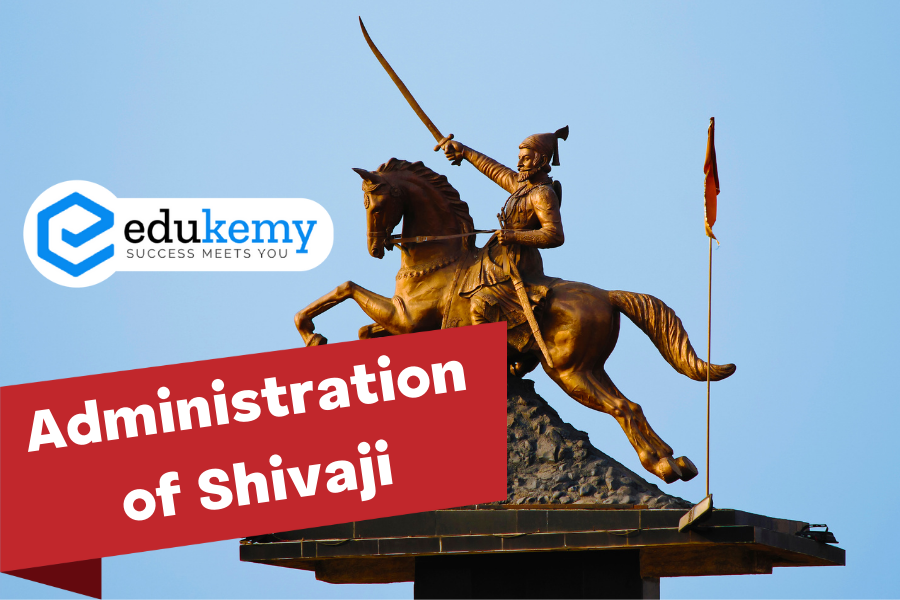
Shivaji was one of the greatest administrators of medieval India and established an efficient administrative system. The council of ministers of Shivaji was known as Asta Pradhans which consisted of 8 ministers. They were:
1. Mukhya Pradhan /Peshwa – Prime Minister
2. Amatya/ Mazumdar- Finance Minister
3. Mantri Waqia-Navis – Minister for home affairs
4. Sumant/Dabir – Foreign Minister
5. Sacheev/ Shurunavis- Minister for royal correspondence
6. Senapati / Sar-i-Naubat – Commander-in-chief
7. Nyayadhish – Chief Justice
8. Panditrao – High priest
Contents
- 0.1 During Rajaram’s tenure, a ninth minister named Pratinidhi was appointed as the head of Asta Pradhans. Other important officers were:
- 0.2 Land revenue was an important source of income for the state. Shivaji collected 40% of the total produce. He introduced two new taxes. They were:
- 0.3 Shivaji took up the following welfare measures:
- 1 Frequently Asked Questions (FAQs)
- 1.1 Q: What were the key principles of Shivaji’s administration?
- 1.2 Q: How did Shivaji establish a strong administrative structure?
- 1.3 Q: What was the role of the ‘Mavalas’ in Shivaji’s administration?
- 1.4 Q: How did Shivaji ensure religious tolerance in his administration?
- 1.5 Q: What was the significance of Shivaji’s naval administration?
- 2 In case you still have your doubts, contact us on 9811333901.
During Rajaram’s tenure, a ninth minister named Pratinidhi was appointed as the head of Asta Pradhans. Other important officers were:
1. Fadnavis- Auditor
2. Jamedar- Treasurer
3. Chitnis- Officer of official correspondence
4. Daftedar- Superintendent
Shivaji divided his kingdom into provinces known as ‘prantas’ and mukhyadeshadhikaris or karkuns as the governors. Each province was again divided into tarafs (districts) administered by tarafdars. The head of the village was called as Patil and was assisted by Kulkarni who maintained the accounts. Kotwal was the in-charge of a town.
Maratha army comprised of two forces. One was Bargi/ Paga (permanent standing army) and the second was Silhadar (temporary soldiers). Shivaji maintained a small naval fleet at Kolaba (Bombay) which helped him in fighting with Siddhis (Negro Musalmans of Abyssinia/ Ethiopia), who were ruling Janjira islands in the Arabian Sea.
Land revenue was an important source of income for the state. Shivaji collected 40% of the total produce. He introduced two new taxes. They were:
(i) Chauth- It was 1/4th of the total produce. It was collected from the neighbouring areas of the Maratha kingdom to avoid the Maratha raids.
(ii ) Sardeshmukh – It was an additional levy of 1/10th of the produce. Shivaji abolished Deshmukh (zamindari) system and ordered the farmers to pay 10% to the government in the form of Sardeshmukh which earlier was being paid to Deshmukhs.
Shivaji took up the following welfare measures:
(i) He imposed restrictions on social evils like sati, dowry, child marriages and exorbitant interest rates.
(ii) He built many roads and bridges.
(iii) He excavated many tanks for potable water and irrigation.
Read our ALL MEDIEVAL HISTORY NOTES.
Frequently Asked Questions (FAQs)
Q: What were the key principles of Shivaji’s administration?
A: Shivaji’s administration was characterized by principles such as decentralized governance, religious tolerance, a merit-based administrative system, and a strong naval force. He emphasized the idea of “Hindavi Swarajya” or self-rule for the people of the region.
Q: How did Shivaji establish a strong administrative structure?
A: Shivaji established a well-organized administrative structure known as the “Ashta Pradhan,” which comprised eight ministers responsible for various aspects of governance. These ministers oversaw areas like finance, justice, military, and intelligence, contributing to an efficient and accountable system.
Q: What was the role of the ‘Mavalas’ in Shivaji’s administration?
A: The ‘Mavalas’ were the backbone of Shivaji’s military and played a crucial role in the administration. They were skilled mountain warriors from the Western Ghats and were instrumental in Shivaji’s military campaigns. Shivaji recognized their importance and provided them with land grants as a reward for their service.
Q: How did Shivaji ensure religious tolerance in his administration?
A: Shivaji was known for his policy of religious tolerance. He treated people of all religions fairly and appointed individuals based on their abilities rather than religious affiliations. This inclusive approach contributed to the harmonious coexistence of Hindus and Muslims in his realm.
A: Shivaji realized the strategic importance of a strong navy for the defense of his coastal territories. He established a robust naval administration, constructing a fleet of warships and coastal forts. This naval force not only protected his territories from foreign invasions but also facilitated trade and commerce.
In case you still have your doubts, contact us on 9811333901.
For UPSC Prelims Resources, Click here
For Daily Updates and Study Material:
Join our Telegram Channel – Edukemy for IAS
- 1. Learn through Videos – here
- 2. Be Exam Ready by Practicing Daily MCQs – here
- 3. Daily Newsletter – Get all your Current Affairs Covered – here
- 4. Mains Answer Writing Practice – here

